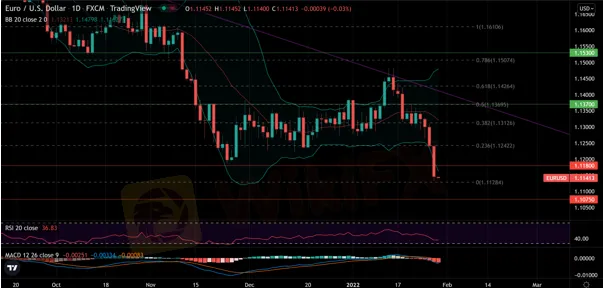简体中文
繁體中文
English
Pусский
日本語
ภาษาไทย
Tiếng Việt
Bahasa Indonesia
Español
हिन्दी
Filippiiniläinen
Français
Deutsch
Português
Türkçe
한국어
العربية
EURUSD New lows following Jerome Powell's hawkish speech
摘要:The dollar has been strengthening against the major currencies since Jerome Powell's press conference last night
The dollar has been strengthening against the major currencies since
Jerome Powell's press conference last night. The EURUSD is falling back
to a near two-month low this morning after the Fed Chairman decided to
take a slightly more hawkish stance, while not indicating anything very
new from the December meeting.
As expected, monetary
policy remained unchanged, except for the end of QE which was announced
for early March instead of late March. Nevertheless, Powell left the
pace of normalization of monetary policy unclear, which does not seem to
have pleased risky assets. In response to a reporter's question, the
chairman left all options on the table to counteract "more persistent
than expected" inflation.
The Chairman even left the
door open for a rate hike at each meeting, seven by the end of the year,
while the Fed usually raises rates at the last meeting of each quarter
(up to four per year).
The most likely scenario for Fed
policy normalization is now a first-rate hike in March, a second in
June, the start of the balance sheet reduction (QT) process by this
summer, a third and possibly a fourth by year-end.
The
Fed's hawkish rhetoric was evident in the jump in the dollar and bond
yields and the fall in gold and risky assets. In addition, rate hike
expectations increased and the probability of a 50-basis point rate hike
in March, the equivalent of two rate hikes, climbed to 20% after
Powell's speech.
From a technical perspective, the
EURUSD price has broken out of the bottom of the ascending channel in
which it has been trading for almost two months and its Bollinger Bands,
which are signals that pave the way for a continuation of the basic
uptrend that we have been experiencing for almost a year.

(Chart Source: Tradingview 27.01.2022)
The
EURUSD has continued its downtrend breaking through last year's low of
$1.1186. The next target in the short term will likely be the symbolic
threshold at $1.10 in the coming weeks.
The next catalysts to follow will be the US household income and consumption data releases on Friday.
Disclaimer:
This material has been created for information purposes only. All views
expressed in this document are my own and do not necessarily represent
the opinions of any entity.
免責聲明:
本文觀點僅代表作者個人觀點,不構成本平台的投資建議,本平台不對文章信息準確性、完整性和及時性作出任何保證,亦不對因使用或信賴文章信息引發的任何損失承擔責任
相關閱讀

Daily Market Recap – EURUSD Rising bond yields strengthen the US dollar
The greenback appreciated against the euro, benefiting from the market's appetite for U.S. government bonds, whose yields are at their highest since the start of the pandemic.

Daily Market Recap – EURUSD Euro boosted after US inflation
European stock markets are moving lower on Thursday after rebounding in the last two sessions in a market context still dominated by inflation and monetary policy issues.

Daily Market Recap – EURUSD Euro could breakout following consolidation phase
The U.S. economy added a meager 199,000 jobs in the final month of 2021, well below market expectations of 400,000.

Daily Market Recap – EURUSD Euro continues its consolidation
The markets are disturbed by the advance of the Omicron variant in Europe and by a blow to the gigantic social reform plan of the American president Joe Biden.
天眼交易商
熱點資訊
頂級交易員的十項任務
等待才是交易的必修課
使用主標MT4/MT5交易軟體的CMCMarkets是否值得信任?平台真實評價完全公開
CA Markets這家交易商是否值得信賴?立即查看平台監管情形、用戶評價、網站概況
全球展業的TIS具高風險隱患?這家交易商究竟是不是詐騙?
避免外匯投資陷阱:投資人必讀指南(附實際案例)
牌照有瑕疵,資訊不透明,Morgans交易平台危機重重!
匯率計算


